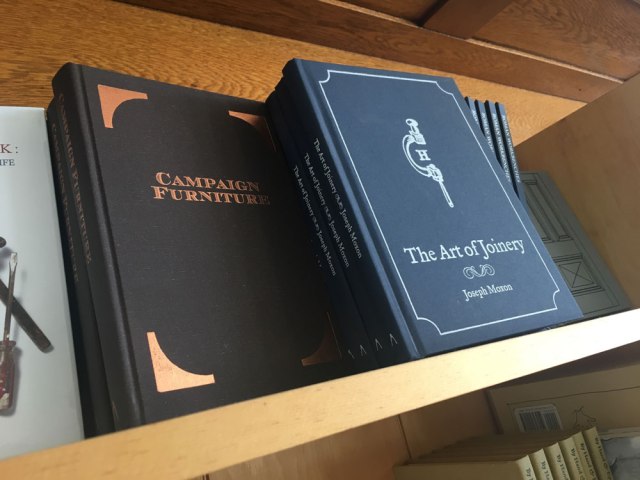
Sometimes a customer asks us to recommend a good place to begin when buying our books.
It’s a question we take seriously. Our books are not cheap, they take time to read and each represents years (sometimes decades) of work to get to press. So recommending one of our 33 books is a bit like matchmaking.
Mentally, I arrange our books into a few “tracks” or “traditions.” Today, I’d like to discuss the United Kingdom tradition.
Joseph Moxon’s ‘The Art of Joinery’
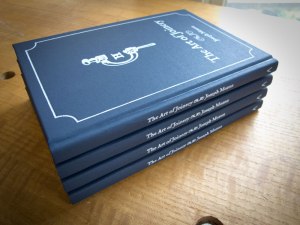 “Mechanick Exercises” by Joseph Moxon was the first English-language book on woodworking. We reprinted his section on joinery, called “The Art of Joinery,” and it was Lost Art Press’ first title in 2007.
“Mechanick Exercises” by Joseph Moxon was the first English-language book on woodworking. We reprinted his section on joinery, called “The Art of Joinery,” and it was Lost Art Press’ first title in 2007.
Moxon’s 17th-century language is a little stilted for modern ears, so I offer commentary on the text and try to explain some of the areas that are confusing. What I love about Moxon is that not much has changed in hand-tool woodworking in more than three centuries. The tools and processes are similar to what I do at the bench every day.
And so the details covered in Moxon are as relevant to me today as when Moxon printed them. Of course, you can get this sort of information from other sources, but understanding the primary source is the best way to separate good technique from Internet self-fondling.
While this was our first book, it’s not necessarily the first Lost Art Press book I’d buy from the U.K. tradition. That book would be Robert Wearing’s “The Essential Woodworker.”
Robert Wearing’s ‘The Essential Woodworker’
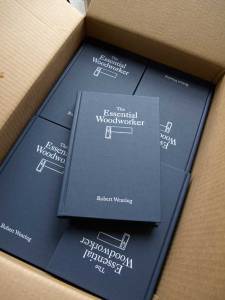 We had to fight like hell to get “The Essential Woodworker” back in print. Though the author was supportive, his previous publishing company was as pleasant as a bag of hemorrhoids. The company destroyed the original files and photos (or said they had been destroyed) and pretty much resisted us at every turn – even though the company had let the book lapse years before.
We had to fight like hell to get “The Essential Woodworker” back in print. Though the author was supportive, his previous publishing company was as pleasant as a bag of hemorrhoids. The company destroyed the original files and photos (or said they had been destroyed) and pretty much resisted us at every turn – even though the company had let the book lapse years before.
So we rebuilt the book from scratch. We typed in every damn word and made revisions from Wearing. We rescanned the line drawings. We took new photos. The result is my favorite book for the beginning hand-tool woodworker.
“The Essential Woodworker” isn’t really about disconnected skills (sharpening, planing, mortising, dovetailing). Instead it connects all these disparate skills into a way that you can see how they are used together to design and build furniture. For many woodworkers, Wearing’s book puts all the puzzle pieces in order and makes it all “click.”
It did for me.
‘The Joiner & Cabinet Maker’
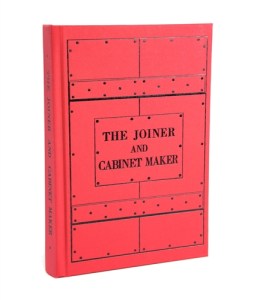 This almost-forgotten book from the early 1800s tells the story of Thomas, a young apprentice in a rural workshop. It is similar to “The Essential Woodworker” in that it provides a framework for learning the craft through three projects: a packing box, a school box and a chest of drawers. But what is different is that all this happens through a historical lens.
This almost-forgotten book from the early 1800s tells the story of Thomas, a young apprentice in a rural workshop. It is similar to “The Essential Woodworker” in that it provides a framework for learning the craft through three projects: a packing box, a school box and a chest of drawers. But what is different is that all this happens through a historical lens.
We took the original short book and printed in its entirety, but we also loaded it with historical context from Joel Moskowitz and a modern interpretation (from me). For me “The Joiner & Cabinet Maker” is for woodworkers who also love the History Channel. It will make you look at your shavings, your folding rule and your name stamp in a different and deeper way.
It will make you appreciate that you cannot spell “woodworking” without “working” and help you grasp why historical technique is sometimes different than what we do today.
And you will loathe Sam, the villain of the book.
Charles H. Hayward ‘The Woodworker, Vols. I to IV’
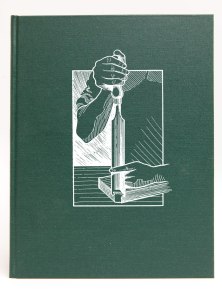 For me, our series of four books from Charles H. Hayward represent the most exhaustive look at the art of joinery in the United Kingdom’s tradition. Hayward, the editor of The Woodworker magazine for more than 30 years, wrote, built and illustrated almost every word of the monthly magazine during his tenure.
For me, our series of four books from Charles H. Hayward represent the most exhaustive look at the art of joinery in the United Kingdom’s tradition. Hayward, the editor of The Woodworker magazine for more than 30 years, wrote, built and illustrated almost every word of the monthly magazine during his tenure.
He was uniquely talented, thoughtful and skilled as a writer, editor, builder, illustrator and publisher.
We sorted through every issue of The Woodworker published during his editorship and, with the assistance of too many people to mention, we culled it all into these four volumes that cover tools, techniques, joinery, workshops and furniture design.
These books are a joy to read casually and are a reference for almost every hand-tool process I know of. These books are for beginners. They are for hard-bitten professionals. They are (and I rarely say this) something that I wish every woodworker would read.
Unlike some practitioners, Hayward wasn’t myopic. He was fascinated by alternative methods from other woodworkers and other cultures. You can even see his own opinion shift on several key items as he listened to his readers.
For a taste of some of Hayward’s genius, check out the table of contents and the free excerpts available here.
And Some Other Titles….
There are other books we have published that are part of the U.K. tradition that focus on narrower topics. “Doormaking & Window-making” explains just that – using the tools and processes common to the U.K. (and North America). “Campaign Furniture” explores an important form of British furniture that doesn’t get much attention. “Welsh Stick Chairs” is one of the most important books on chairmaking (it’s from Wales). And “Cut & Dried” spends a good deal of its pages explaining the woods common to the U.K. and how they are cut, dried and used.
Next – the French tradition.
— Christopher Schwarz